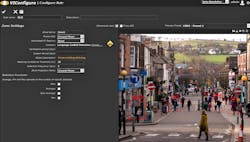Video analytics firm Ipsotek looking to increase footprint in U.S.
One of the new exhibitors at GSX this year isn’t a new company, per se, but plans to have a lot to say about its video analytics capabilities at the show.
London-based Ipsotek is a pioneer in the field of artificial intelligence video analytics (AVIA) and scenario-based “intelligent video analytics.” Founded in 2001, the company is active in a wide variety of verticals, including critical infrastructure, airports, city surveillance, government, retail and transportation, among others.
After being acquired by Atos, a French organization with offices in the U.S., Ipsotek is setting its sights on growing its footprint here. Atos is a major IT services provider that has relationships with large enterprise customers, including hyper-scalers Google and Microsoft.
Boghos Boghossian, Ipsotek’s Chief Technology Officer and Global Sales Director, says the company started using artificial intelligence in 2018 to augment its scenario-based rules engine, ushering in capabilities such as multi-camera tracking.
“This allowed us to do things like track individuals in a crowd. Before it was impossible, but with AI we could track 250 people in the same scene, in a crowded scene,” Boghossian says.
The company could not only identify attributes around gender, age or type of clothing, but could perform re-identification based on appearance, “so we can search and find people across multiple cameras based on how the human body is moving, such as if somebody's having a fight or they have fallen down.”
Doing What’s ‘Natural’
Ipsotek reached another milestone in April with an upgrade of its AIVA engine that allows users of its VISuite platform to search and identify objects in videos using natural language search (NLS), or everyday spoken language.
AI models within computer vision platforms typically rely on predefined criteria and options for detecting objects and behaviors. Leveraging NLS helps VISuite users broaden their detection criteria to include keywords and descriptions of their choice, providing enhanced flexibility and coverage for their use cases.
Ipsotek says this more enhanced capability from AVIA opens doors to a “vast array of potential applications, empowering users to address unforeseen challenges and optimize video analytics across diverse industries.”
Boghossian says the company’s AI models, trained on copious amounts of CCTV-type footage is now augmented by a large language model, allowing the searcher to describe objects and concepts they’re trying to detect.
“You can select different behaviors and link them together in the advanced rule engine and create a use case or scenario,” he explains. “You can say, ‘I would like to detect a person taking a photo using a mobile phone. That’s a specific combination of an object and behavior that is described in a natural language, which then converted to a concept and then looked for across thousands of cameras. And as soon as that's picked up, you get an alert.”
An example might be theaters and museums where patrons aren’t allowed to take pictures, where the use of natural language is easier than having to select from a dropdown menu on different classes or behaviors.
Boghossian says Ipsotek has clients already using the company’s technology that can now deploy it on a wider scale due to the enhancements that removed some obstacles due to hardware specifications and other factors.
“For example, we have a client who is a smart city project with access to 20,000 cameras. They could only do it across 5,000 cameras because the hardware otherwise would've been prohibitive. With the natural language, we suggested they could look for behaviors that are not necessarily going to go away that quickly,” he says, citing a flood or accident congestion as examples.
“We are now giving you better results, as opposed to the user needing to create a multi-stage filtering process where you describe behavior by detecting multiple sub behaviors and connecting them together.”
Creating Flexibility
The development of Ipsotek’s scenario-based rule engine goes back to 2006. As the company started deploying its product it noticed that many clients wanted algorithms to be configured differently to give them a different scenario or use case.
“So, we went back to R and D to think about how we can create a rule engine that’s flexible enough to be configured, rather than develop all of these different scenarios,” Boghossian recalls. “Currently, the scenarios rule engine has more than 65 behaviors in it -- a person in a zone, a person crossing a line, a person on the floor.
“These can be linked either concurrently or sequentially to build the final scenario. And you can say detected smoke at the same time, saw somebody running, and then afterwards an access control system triggered an alarm to say the door had been forced open.
“So, you can combine not only vision-based but also third-party signals into this rule engine and build your scenario. And only when those conditions which are linked with Boolean logic and sequentially you have conditions one, two, and three, only then the event will trigger.”
Boghossian says Ipsotek is attending GSX to showcase its new technology, keep strong contact with end customers to understand their pain points and needs and continue building dialogue with partners and systems integrators who are looking for new client solutions.
Ipsotek is currently deeply involved in the aviation industry, working in more than 90 airports globally and recently winning its first U.S. contract at a major New York airport.
“The technologies we bring will make those airports safer, but at the same time there are operational aspects where we can help in the management of the passengers. You have health and safety aspects which come under regulations,” Boghossian says.
“But we also have the business intelligence aspect of the product. We collect lots of KPIs and provide dashboards. That will help our clients -- not only airports, but generally to better streamline their operation but also enhance the customer experience.”
About the Author
John Dobberstein
Managing Editor/SecurityInfoWatch.com
John Dobberstein is managing editor of SecurityInfoWatch.com and oversees all content creation for the website. Dobberstein continues a 34-year decorated journalism career that has included stops at a variety of newspapers and B2B magazines. He most recently served as senior editor for the Endeavor Business Media magazine Utility Products.

